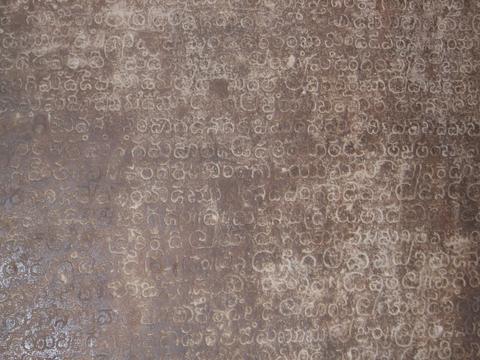This paper was published in August 1935 in The Jaina Gazette (Vol. XXXII, No. 8, pp. 233-235).
During my stay in South India I had the occasion to collect the following few notes regarding Kannada (Kanarese) literature which I give below, in the hope that they will stimulate the interest of scholars and bring that great provincial literature of the Canarese closer to us. It will also incidentally give the readers an idea as to how India -a huge sub-continent of vast dimensions and distances, of apparent diversity in language, culture, customs and manners - still has the same soul breathing throughout its length and breadth, the same undercurrent of thought, the foundation of life.

Kanarese stone inscription from Virupaksha Temple at Pattadakal
Kannada is the principal language of the Mysore State and adjoining tracts. It is also called "Karnata" or "Karnataka" - these being the Sanskrit forms. The origin of the word and its primary meaning are still the subjects of controversy. One school holds that the original expression was “Kari-Nadu” which in Kannada means “the country of black soil”. Another school would derive the name from the Sanskrit phrase “Karnata” interpreting this as “that which haunts the ear”. Whichever the correct theory, the word “Kannada” and its Sanskrit variants have for centuries been in use as the names of both the country and the language. The total all-India Kannada-speaking population in 1921 was 10,374,204 souls.

In his “Lives of Kannadi Poets” (in 3 vols) Syt. R. Narsimhacharya, a former Director of Archeological Reseaches in Mysore and an authority on the subject, enumerates writers in Kannada upto the close of the 19th century - and they number 1148. Of these 175 are Jains, 453 Veer Saivas, 388 Brahmins and 132 others. Some 42 of these are women and 25 kings or chieftains.
The earliest works we have are those composed by Jains. They stand unsurpassed, for beauty of style and freshness of conception. Some of the leading Jain writers and poets of Kanarese have been:
- Pampa or Adipampa- Born 902 A. D. in Vengi country of a Brahmin family which had adopted the Jain faith. He was the court-poet of King Ari-kesari of the Chalukya-Dynasty at Puligere. Some of his Works are: “Adi Purana“ and “Vikramajun-Vijai“. The first is the life story of a Jain saint; the second is a version of the Mahabharata. These works - particularly the latter - are among the highest achievements of the poetic art in Kannada. By the noble and graceful individuality of his style, by his power of reproducing the stir and the pathos, and the movement of great scenes, by his skilful economy of narrative and description, and by his deftness in the delineation of character, Pampa stands pre-eminent.
- Rama, about 949-993. A Jain author of bangle-seller's caste. Born at Mendhol - obtained the patronage of the Chalukya Prince Tailapa. Works: “Gada Yuddha“, “Ajita-Puran“ etc. The first is a master-piece revealing a supreme gift of vividness in depicting scenes, tragic as well as heroic.
- Nagachandra or Abhinava Pampa, about 1100 A.D. A Jain author probably of Bijaipur. His version of the “Ramayana“ is a celebrated work, has an elegant and melodious style.
- Aandayye, about 1235. A Jain author of “Kabbigare kava“ or the “Protector of poets“. It is also celebrated as “Cupid's Truimph” and “Beauty's harvest." The first name has its origin in the poet's motive of writing in chaste Kannada so as to repel the charge that Kannada poets, cannot write without the admixture of Sanskrit. He was thus a purist and protestant against over-Sanskratization. He was however obliged to karnatakize Sanskrit words for his purpose. His theme is a love-romance and he executed his task with rare freshness, charm and elegance.
- Kesiraja, about 1200. A Jaina author of the Hoysala country. Author of “Sabda-Ravi-Darpana“ a famous metrical work on Grammar. It is a standard work for old and middle Kannada.
- Bhatlakalanka, A.D. 1604. A Jain author; he composed “Shabda-Anushasan“, a work on Kannada Grammar in the manner of Panini.
 Siddha-raj Dhadda
Siddha-raj Dhadda